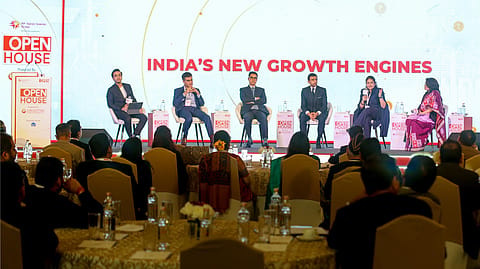'Not Great Wall, focus on Taj Mahal': Top industry experts open up on the new engines of growth India must focus on
As India embarks on its next phase of economic growth, leading experts gathered on Monday at RP Sanjiv Goenka Group's flagship event, Open House for a panel discussion on "India’s New Growth Engines."

As India embarks on its next phase of economic growth, leading experts gathered on Monday at RP Sanjiv Goenka Group's flagship event, OpenHouse for a panel discussion on "India’s New Growth Engines", exploring key sectors driving the country's future expansion.
Speaking at the panel, Preeti Bajaj, CEO and MD, Luminous Power Technologies, emphasised that renewable energy remains a priority sector for the government, particularly in terms of capital allocation.
“We have been intentional about this growth,” said Bajaj.
A key indicator of this commitment is the increased allocation for the Pradhan Mantri Surya Yojana, the government’s flagship renewable energy program. The budget for this initiative has been raised from ₹11,000 crores to ₹20,000 crores, signalling a clear shift from intention to action.
“The government has definitely produced a budget of resolve, of resilience and of the rise of the consumer spending ability,” Bajaj added.
However, she added that, “As we move forward to remain on track, our execution capabilities have to be doubled down.”
Bajaj said that for this growth engine to function properly, the focus must now also be on the efficiency of project deployment.
Recommended Stories
“So, 1 crore is the number of households that we said we are going to solarise in this country…7,00,000, that's all we've done, 93 more lakh houses have to be getting this solar scheme. Can you imagine?" Bajaj added.
This reveals that while renewable remains a promising area of growth, execution with efficiency would be a bigger problem to tackle for the country, Bajaj noted.
Meanwhile, Manish Sharma, chairman and CEO, Panasonic Life Solutions India and South Asia, believes that the country's electronics sector is poised for significant expansion, as the government aims to scale up production from the current $20 billion to an ambitious $500 billion by 2030.
However, Sharma said that a more realistic approach suggests a target of $425 billion.
Currently, value addition within India stands at 23%, amounting to approximately $27-28 billion in the domestic value chain. Sharma added that studies project that by 2030, 45% of the $425 billion target could be value-added within the country. This would generate a compounding impact, potentially increasing the domestic electronics ecosystem to $70 billion.
In an environment where the electronics industry is poised to become the new engine of growth, Sharma highlighted that while semiconductors are a critical enabler of this growth, the country must adopt a “parallel approach” and focus on strengthening the entire electronics ecosystem.
Sharma said that the focus should now be on intellectual property (IP) and design to enhance India's control over technology development.
Building on this, Sachin Chopra, CEO and founder, Alpha Vector, used the analogy of Taj Mahal and Great Wall of China, highlighting that the country can never match China in scale and henceforth not focus on imitation but instead must focus on design.
“We got to focus on high voltage… on power electronics…on AI consumption, the chips that can be used for that. But why make it? Because we will never, ever be able to put that scale in,” Chopra said.
As India moves to cash in on the new growth engines, Vineet Agarwal, MD, Transport corporation of India, said that the latest budget's focus on consumption will indeed have a multiplier effect, particularly in relation to infrastructure investment, consumer demand, and private sector growth.
The budget is designed to put more money into the hands of consumers, boosting spending. Yet, private companies have been hesitant because of excess production capacity in some industries. With rising consumerism, private sector investment should finally pick up, breaking the cycle of underinvestment, Agarwal hoped.
Agrawal added that while FMCG companies’ revenue numbers may not seem promising, many local brands are flourishing in specific regions, boosting domestic consumption beyond just large corporations.
Agrawal also talked about as India gears up for rapid changes in FMCG industry with quick commerce emerging on the fore, he said that the costs remain immensely high.
“Instant gratification is a new-generation phenomenon,” Vineet
However, supply chain networks are changing more rapidly as a result.
“Any of the new products means a completely new generation of logistics opportunities. Many years ago, there was nothing like telecom industry,” Agrawal added.
Yet Agarwal said that there remains uncertainty on how many of the newer players driving the new growth engines will survive is entirely a question of their propensity to invest and spend.
“How many will survive depends on how much money can they throw,” Agrawal added.